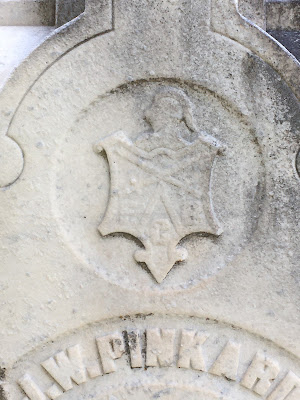So there we were, three members of the Sons of Union Veterans of the Civil War, all there with but one purpose: to clean the gravestone of Capt. William S. Parmley (1834-1885). Not only did Capt. Parmley serve in the 33rd Iowa Infantry during America's Civil War, but after that conflict he helped to establish the Fort Worth, Texas Post No. 4 of the Grand Army of the Republic and was for some time its Commander.
The GAR was a nationwide association of Union veterans established following the war. The Sons of Union Veterans, wishing to carry on the ideals of the GAR of Fraternity, Charity, and Loyalty as their ranks were dwindling in the early 20th Century owing to the deaths of their members, became the successor organization, and continues to honor the memory of their service and sacrifice in maintaining the Union.
Following his death in 1885, Post No. 4 was named in honor of Capt. Parmley.
So we were there to clean his marker of the dirt, grime, and lichen which was growing on it, as a token of our respect for his service both during the Civil War and after in the GAR.
But as is often the case, particularly to me as a herald, it always pays to look at my surroundings. And while looking around nearby Capt. Parmley's gravesite, wouldn't you know it, but I found some heraldry - or at least some heraldry-like depictions - right there "in the wild" as it were.
The first was on the grave marker of Charles Mortimer Brown (1867-1897) and Joseph Mortimer Brown (1816-1899).
A close-up shows a "heraldry-like" object, consisting of a tilted shield topped by a helmet and crest (this latter is very difficult to make out, but further research indicates that it is an eagle), the shield surmounted by two battleaxes in saltire. This is the emblem of the Knights of Pythias, a fraternal organization founded in Washington, DC in early 1864.
The other heraldic item is on the grave marker of J.W. Pinkard (1852-1885).
On Mr. Pinkard's marker, the carving is a little more heraldic, but I have not (yet) been able to identify it.
On the shield, which is topped by a helmet and what looks like a horsetail crest, in chief there are two crossed swords and in base a chevronel separating the letters F, C, and (I believe) B.
I suspect that this is one or another of the many fraternal organizations which were formed in the latter half of the 19th Century, but I have been thus far unable to identify it for certain. It bears some resemblance to some of the Knights of Pythias emblems, but I've been unable to find this particular design amongst them. And while the F, C, B matches the Knights' motto of Friendship, Charity, Benevolence, their designs generally place the B in base rather than the C.
So is this bit of heraldry also a Knights of Pythias emblem? It may be, as there are some similarities, but as I've found no insignia of the Knights that contain two swords in chief (any crossed weapons are always the battleaxes), I am hesitant to make a firm identification without further study.
In any event, it was serendipitous to find these two bits of heraldry while spending time in a cemetery for something else altogether.
As I've said any number of times, and this time once again demonstrates the point: "You can find heraldry everywhere!"














No comments:
Post a Comment